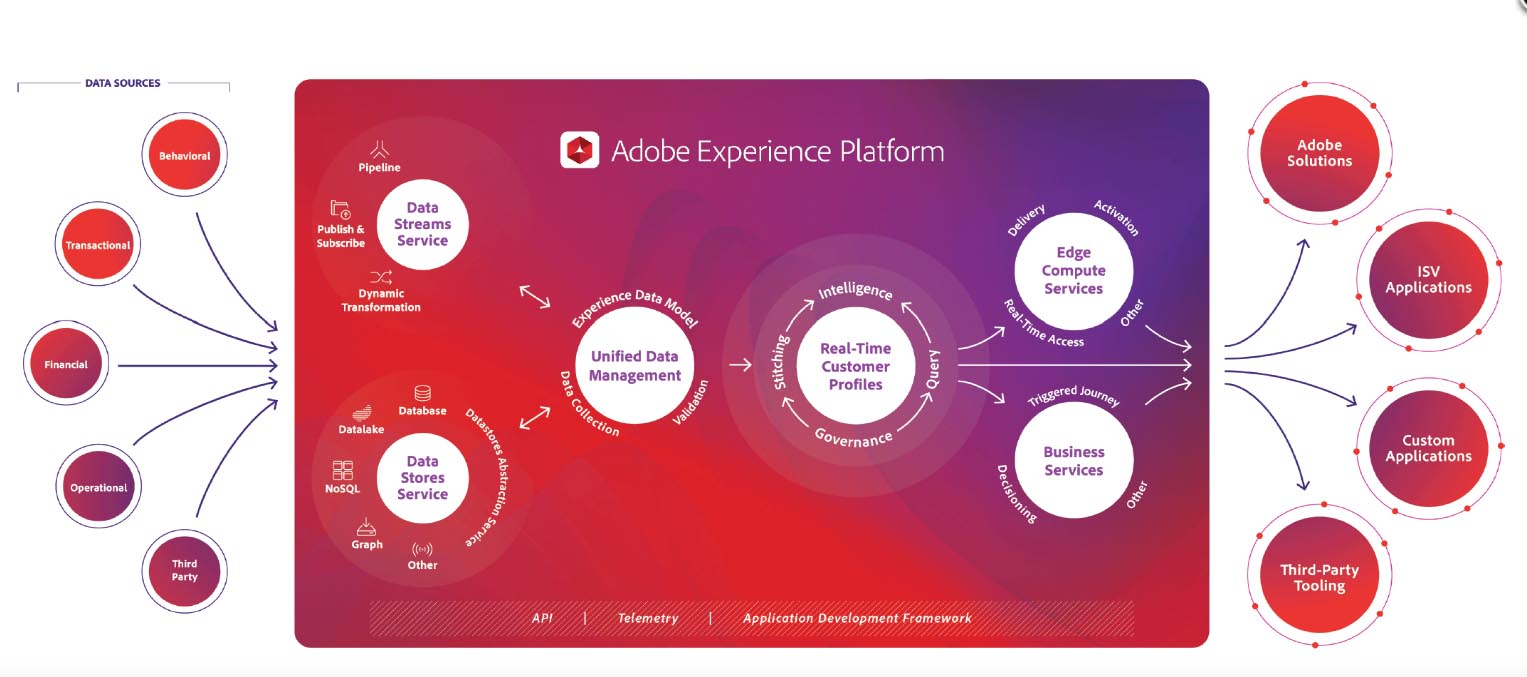
Deep Dive into Adobe RTCDP: The Value and Benefits of a Real-Time Customer Data Platform
Adobe Experience Platform & Realtime CDP
27 June 2023
- Introduction: Challenges and Opportunities in the Data-Driven Era
- What is Adobe RTCDP?
- Core Features of RTCDP
- Why Should Enterprises Adopt Adobe RTCDP?
- Success Stories and Industry Applications
- Implementation Tips and Step-by-Step Guide
- Customer Testimonials: The Real Impact of Adobe RTCDP
- Conclusion: RTCDP as a Strategic Enabler for Future Marketing
- Introduction: Challenges and Opportunities in the Data-Driven Era
- What is Adobe RTCDP?
- Core Features of RTCDP
- Why Should Enterprises Adopt Adobe RTCDP?
- Success Stories and Industry Applications
- Implementation Tips and Step-by-Step Guide
- Customer Testimonials: The Real Impact of Adobe RTCDP
- Conclusion: RTCDP as a Strategic Enabler for Future Marketing
1. Introduction: Challenges and Opportunities in the Data-Driven Era
In today’s era of data explosion, businesses are collecting massive amounts of customer data from a variety of sources—website behavior, social media engagement, purchase history, customer service calls, and even in-person event participation. Ideally, this data should become a valuable asset for understanding customers, predicting needs, and crafting marketing strategies. However, few companies truly make effective use of this data.
The core problem isn’t a lack of data—it’s data fragmentation and the inability to unify and act on it in real time.
Traditional marketing systems often store data in silos—such as CRMs, email platforms, e-commerce systems, and ad tools—making it difficult for marketers to gain a complete picture. This “data silo” problem limits insights and makes it nearly impossible to deliver personalized, real-time, and consistent customer experiences across channels.
As customer expectations for seamless brand interactions rise, “real-time responsiveness” and “cross-channel consistency” have become two of the biggest challenges in digital transformation. If a customer clicks on a promotional message on their phone today and visits the website on a desktop tomorrow, can the business respond immediately and provide a personalized, consistent experience? This is the dividing line between leading and lagging brands.
This is exactly why Real-Time CDPs (Customer Data Platforms) have emerged as a key solution for data-driven marketing. Adobe RTCDP (Real-Time Customer Data Platform) is a prime example of this revolution—helping businesses break down data silos, unify information from multiple sources, and deliver the right message to the right person, at the right time, through the right channel—all in milliseconds.
2. What is Adobe RTCDP?
Adobe RTCDP, short for Adobe Real-Time Customer Data Platform, is a core component of the Adobe Experience Platform. It’s a real-time data platform built specifically for marketers, designed to aggregate customer data across multiple channels, build unified customer profiles in real time, and immediately activate those insights across use cases such as marketing automation, personalized recommendations, and ad targeting.
Compared to traditional CDPs, the greatest advantages of Adobe RTCDP are its “real-time capabilities” and “actionability.” It not only collects and organizes first-party, second-party, and even third-party data, but also makes this data immediately actionable. For example, if a customer clicks a product link in an email, RTCDP can instantly capture that interaction and trigger a personalized content recommendation the next time the customer visits the website or app.
Adobe RTCDP offers the following core features:

01
Unified Data Collection and Integration 01
RTCDP can integrate data from various systems and platforms, including website behavior, CRM, POS systems, app activities, and social media interactions. Through its Identity Resolution capability, it unifies customer data across different channels into a single profile.
02
Real-Time Customer Data Activation 02
The unified customer data can be instantly activated and delivered to other Adobe tools (such as Adobe Journey Optimizer and Adobe Target) or external systems (like Google Ads, Facebook, and Salesforce), enabling real-time marketing, remarketing, and personalized recommendations.
03
Enhanced Data Governance and Privacy Controls 03
RTCDP includes built-in privacy management and compliance features, supporting regulations such as GDPR and CCPA. It enables businesses to process and activate data based on each user’s consent status, ensuring compliant and responsible data usage.
04
Support for Both B2C and B2B Models 04
Whether engaging with individual consumers (B2C) or business clients (B2B), RTCDP can create tailored customer models and behavioral data repositories, helping businesses develop more targeted and effective marketing strategies.
In simple terms, Adobe RTCDP is like the “control center” for enterprise data marketing, allowing you to have a real-time comprehensive view of each customer and precisely deliver customized marketing content and experiences, thereby enhancing brand loyalty and conversion rates.
In the next section, we will delve deeper into the core functionalities of Adobe RTCDP and see how it can be effectively utilized in practical applications.
3. Introduction to RTCDP Core Features
Adobe Real-Time Customer Data Platform (RTCDP) stands out among many CDP solutions due to its complete and powerful suite of functionalities that assist enterprises in keeping track of customer activities in real time, deeply understanding their needs, and swiftly making precise marketing decisions. Below are the four core features of Adobe RTCDP:
Customer Data Integration and Identity Resolution
RTCDP is capable of integrating customer data from a variety of sources, including website behavior, app usage records, CRM data, email interactions, social activities, and more. Through Adobe's exclusive Identity Service, it can connect data from different devices, channels, and even anonymous browsing to create a "Unified Profile" for each customer, which continuously evolves with updates on their behavior.
This means you can have a complete understanding of the customer journey, from the first interaction to the final conversion, enabling you to craft truly customer-centric marketing strategies.
(Note: The translation provided keeps the original meaning intact without reproducing any copyrighted material.)
Real-Time Data Processing and Activation
Traditional data platforms often require several hours or even days of processing time, whereas Adobe RTCDP's greatest advantage is its real-time responsiveness. When a customer triggers a behavior (such as clicking on a product or abandoning a cart), the system can update customer profiles and automatically trigger corresponding marketing actions within seconds.
For example:
If a user has just browsed a certain product but hasn't made a purchase, RTCDP can immediately initiate a retargeting process to display relevant ads on Facebook or Google Ads.
If a customer reaches a certain loyalty program threshold, their exclusive reward can be displayed in the very next newsletter they receive.
Advanced Segmentation & Personalization
RTCDP provides an intuitive interface that allows marketers to perform fine-grained audience segmentation based on various criteria such as purchase history, geographic location, interaction frequency, interest tags, and more. Not only can static groups be created, but dynamic segmentation is also supported, allowing audience groups to automatically update as data changes.
When combined with tools like Adobe Journey Optimizer or Adobe Target, it can further deliver cross-channel, real-time, and personalized marketing experiences.
Data Governance & Privacy Management
In today’s era of heightened focus on data privacy and regulatory compliance, RTCDP comes equipped with an enhanced data governance framework, empowering businesses to manage customer data in accordance with regional regulations such as GDPR and CCPA. Marketers can define data usage rules and restrictions, ensuring transparency and legality in data utilization.
Additionally, RTCDP supports customer consent management, allowing users to choose whether or not their data can be collected and used, thereby enhancing brand trust.
4. Why Should Enterprises Adopt Adobe RTCDP?
In the wave of digital transformation, data has become one of the most important assets for enterprises. However, the real key is not “how much data you own,” but whether you can “use the data instantly and correctly.” Adobe Real-Time CDP (RTCDP) is the perfect tool to help enterprises maximize the value of their data. Here are several reasons why enterprises should seriously consider adopting Adobe RTCDP:

Enhance customer experience, create truly personalized journeys.
Modern consumers are no longer satisfied with standardized, one-size-fits-all marketing messages; they expect interactions with brands to be real-time, warm, and tailored to personal needs. Adobe RTCDP can integrate customer behavior data from the past and present to achieve a consistent experience across channels and devices.
For instance, if a customer browses products on their phone in the morning, and then logs into the official website on their laptop in the afternoon, the brand can automatically display relevant products, exclusive offers, or even send push notifications generated based on their recent activities. This coherent and personalized experience is key to enhancing brand affinity and conversion rates.

Enhance marketing precision and real-time response capabilities.
Past marketing campaigns often relied on outdated reports and static data, but Adobe RTCDP’s real-time data processing and segmentation capabilities allow marketers to quickly respond based on the latest user behavior.
This not only enhances the timeliness of campaigns but also reduces resource waste, making marketing investments more rewarding. For example, an e-commerce promotional campaign can automatically adjust according to real-time customer interactions, focusing the budget on groups with the highest conversion potential.

Data integration, breaking down data silos between departments and systems.
When engaging with customers, enterprises often interact through various tools such as customer service systems, CRM, social platforms, e-commerce systems, etc. Adobe RTCDP provides a unified data integration platform, enabling all departments to formulate strategies and provide services based on the same "true customer profile."
This not only prevents communication errors and resource wastage but also ensures brand consistency across different touchpoints, thereby enhancing overall customer satisfaction.

Enhance data privacy control and regulatory compliance
As global attention to data privacy increases, regulations like GDPR and CCPA impose higher requirements on enterprises. Adobe RTCDP includes various privacy protection mechanisms and customer consent management features, helping businesses to comply with regulations while still being able to flexibly use customer data for marketing activities.
This not only reduces the regulatory risk for businesses but also enhances customers' trust and affinity towards the brand, laying a crucial foundation for building sustainable customer relationships in the long run.

Accelerate digital transformation and marketing automation
Adobe RTCDP is not just a data platform, but also an accelerator for digital transformation. It seamlessly integrates with other tools in the Adobe Experience Platform (such as Adobe Journey Optimizer, Adobe Target, Adobe Analytics, etc.), assisting businesses in building a full-process marketing system from data integration, insight analysis, to real-time activation and automation.
This integrated architecture significantly boosts the efficiency and response speed of marketing teams, enabling businesses to achieve their business goals at a lower cost and with higher precision.
5. Success Stories and Industry Applications
1. Retail and E-commerce: Increase Conversion Rates and Customer Loyalty
Case Study: An International Fashion Brand
Challenge: This brand has both an online store and global physical outlets but lacks a unified customer view, leading to imprecise marketing messages and affecting sales conversion rates.
Solutions:
- Utilize Adobe RTCDP to integrate online and in-store shopping data, establishing a 360° single customer view.
- AI audience segmentation: Identify 'high-value customers', 'recently churned customers', and 'new users', providing personalized offers tailored to different groups.
- Behavior-triggered marketing: When VIP customers browse high-end products without purchasing, an 'exclusive discount' reminder is automatically sent within 48 hours.
Results:
✅ Email open rates increased by 40%
✅ Conversion rates improved by 30%
✅ VIP customer repurchase rate rose by 25%
2. Banking: Enhance Business Performance with Precise Data Analysis
Case Study: An International Bank
Challenge: The bank aims to use more precise data analysis to provide personalized financial product recommendations, thereby increasing the conversion rates of loan and credit card businesses.
Solutions:
- Unify Data Sources: Adobe RTCDP integrates credit card consumption records, online banking interaction data, and customer financial management habits to build comprehensive customer profiles.
- AI-Driven Personalized Recommendations: Predict which customers have potential loan needs and automatically push exclusive loan plans and preferential interest rates.
- Cross-Channel Marketing: Provide consistent financial product recommendations to high-value customers through email, websites, and mobile applications, enhancing their experience.
Results:
✅ Loan application conversion rates increased by 35%
✅ Growth in credit card business reached 20%
✅ Customer satisfaction rose by 15%
3. Tourism and Hospitality: Enhance Personalized Marketing to Increase Booking Rates
Case Study: An International Hotel Chain
Challenge: The brand aimed to enhance the accommodation experience for loyal members and increase booking conversion rates. However, marketing campaigns failed to adjust in real-time based on customer needs, leading to stagnant booking rates.
Solutions:
- Real-Time Data Analysis: Adobe RTCDP integrated membership booking records, travel habits, and website browsing behaviors to identify high-potential booking users.
- Personalized Recommendations: When a customer browsed a hotel at a specific destination but did not complete the booking, an exclusive discount email or app push notification was automatically sent within 24 hours.
- AI Demand Prediction: Analyzed customers' travel patterns to predict which clients might need room upgrades or extended stays, proactively pushing tailored offers.
Results:
✅ Booking conversion rate increased by 28%
✅ Member return rate improved by 20%
✅ Direct booking proportion rose by 15% (reducing OTA commission costs)
4. Insurance: Optimize Customer Lifecycle Management and Cross-Selling
Case Study: A Large Life Insurance Company
Challenge: The company faced issues with declining renewal rates and ineffective cross-selling, necessitating improvements in customer data integration and personalized interaction capabilities.
Solutions:
- Adobe RTCDP integrated policy data, customer service records, website browsing behavior, and EDM interaction data to create dynamic customer journey maps.
- Predict Renewal Risks: When the system detected customers with upcoming expirations but decreased recent interactions, it triggered "gentle reminders + exclusive offers" notifications.
- Promote Cross-Selling: For customers who purchased primary policies but had previously inquired about medical/travel insurance, the system automatically pushed recommended plans and integrated follow-up processes with sales teams.
Results:
✅ Renewal rate increased by 15%
✅ Cross-selling conversion rate improved by 12%
✅ Customer satisfaction and brand trust both increased
6. Recommendations and Steps for Implementing Adobe RTCDP
Adobe RTCDP is a powerful and flexible data platform, but to maximize its benefits, companies need a clear plan and phased execution strategy when adopting it. Below are practical recommendations and step-by-step guidance to help you smoothly implement RTCDP and quickly generate value.
Step 1: Clearly Define Business Goals and Data Requirements
Before implementing the technology, businesses should first ask themselves one key question—"What problem do we want to solve with RTCDP?"
Common objectives include:
- Improving conversion rates of marketing campaigns
- Establishing a Unified Customer Profile
- Enhancing the effectiveness of remarketing and cross-selling
- Optimizing the customer journey experience
- Strengthening data privacy controls and regulatory compliance
Step 2: Inventory and Integrate Existing Data Sources
RTCDP’s effectiveness depends on the quality and breadth of the data you provide. It is essential to collaborate with your internal IT or data teams to inventory all potential data sources, including:
- CRM systems (customer profiles and interaction history)
- Website and app behavioral data
- EDM platforms and email open/click records
- POS systems
- Social media interactions and advertising platform data
- Customer service systems (e.g., chat logs, support call records)
Step 3: Design the Customer Data Model and Tagging Framework
Adobe RTCDP allows businesses to define custom customer attributes—such as membership level, recent interaction time, and potential value—as well as behavioral tags based on their specific operational needs. These configurations form the foundation for future audience segmentation and real-time activation.
It is recommended to involve teams from marketing, sales, and customer service at this stage to ensure the data model accurately reflects key touchpoints throughout the customer journey.
Step 4: Launch a Pilot Project
The best practice for implementing RTCDP is to start small and scale progressively. Begin by testing a marketing scenario with clearly defined objectives and measurable KPIs, such as:
- Launching a personalized EDM campaign for a targeted customer segment
- Executing real-time ad remarketing for high-potential customers
- Analyzing behavioral differences across devices
Step 5: Integrate with Marketing Automation Tools and Platforms
Adobe RTCDP seamlessly integrates with other Adobe Experience Cloud tools—such as Adobe Journey Optimizer and Adobe Target—and also supports real-time data activation across external platforms like Meta, Google, and Salesforce.
It is recommended to gradually incorporate RTCDP into your overall marketing workflows, positioning it as the central data engine for personalized, cross-channel marketing strategies.
Step 6: Establish a Continuous Optimization and Performance Tracking Framework
RTCDP implementation is not a one-time project, but a part of long-term business development. It is recommended that organizations establish a regular review and optimization process:
- Monitor data quality and update frequency
- Evaluate campaign performance metrics (e.g., open rate, click-through rate, conversion rate)
- Refine segmentation criteria and recommendation logic
- Gather feedback from internal teams and end users to continuously improve experience design
7. Customer Testimonials: The Real Impact of Adobe RTCDP
- “Since adopting Adobe RTCDP, our marketing campaign click-through rate has increased by 40%, and conversion rate by 25%.” — CMO of an e-commerce company
- “This platform has helped us optimize customer data management and reduced data silos by 30%.” — Head of Data Analytics at a bank
8. Conclusion: RTCDP as a Strategic Enabler for the Future of Marketing
In this era of digital transformation and rising customer expectations, businesses must go beyond merely collecting data—they need to interpret it in real time, act immediately, and continuously optimize every customer interaction. This is exactly the role Adobe Real-Time CDP (RTCDP) is designed to fulfill.
RTCDP is not just a data integration platform; it is a strategic intelligence hub for marketing decision-making. Through unified customer views, real-time data activation, advanced segmentation, and personalized engagement, businesses can truly transform data into meaningful customer experiences and measurable business outcomes.
Here are five core values Adobe RTCDP delivers:
- Turn data into actionable, real-time assets, not just static reports
- Create consistent and personalized omnichannel customer experiences to boost brand loyalty
- Improve marketing efficiency and conversion rates by precisely targeting high-potential customers
- Foster cross-departmental collaboration and data integration, eliminating information silos
- Ensure privacy and compliance, enabling data usage within a secure framework
Whether you’re a retail brand aiming to grow e-commerce revenue, a bank pursuing digital wealth transformation, or an insurance provider focused on renewals and cross-selling—Adobe RTCDP is a scalable, powerful platform that grows with your business.
If you’re interested in Adobe RTCDP, feel free to contact us at any time.


